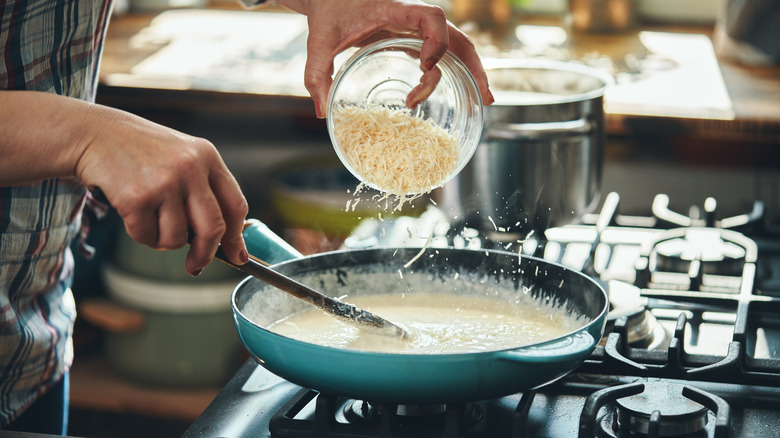The Simple Temperature Mistake That's Turning Your Alfredo Sauce Into A Broken Mess (And How To Prevent It)
Scratchmade Alfredo sauce, like our easy Alfredo recipe, only takes a few ingredients to make. But no matter if you're making Alfredo at home or heating up a jarred sauce, temperature plays a crucial role in its success — or demise. Alfredo sauce is an emulsified sauce that's made by mixing two immiscible ingredients, namely water and fat. Alfredo sauce mixes butter, cream, and Parmesan over the stove, whisking the mixture into the creamiest, smoothest consistency.
Unfortunately, high temperatures are a common mistake with Alfredo sauce that can turn it into a mess. When a sauce "breaks," it refers to the separation of water from fat, which results in an oily, clumpy, and all-around unpleasant texture. An emulsion is a delicate mixture that requires a low simmer and gentle heat. Even simmering your sauce on low heat for too long can break it.
The key to preventing Alfredo sauce from breaking due to temperature is patience and attention. You want to heat your ingredients slowly, monitoring them closely. Once the cream and butter have started to bubble, you should keep the mixture at a low simmer for just a few more minutes to thicken. Then be sure to take it off the heat immediately.
How to properly fix broken sauces and reheat them
Even bottled sauce that's successfully emulsified in factories will break if reheated over high heat. So, there are really no shortcuts when it comes to Alfredo sauce; slow and steady wins the race. You want to slowly increase temperatures while doing plenty of stirring to ensure the sauce stays emulsified, whether you're making it fresh or reheating it.
If you're reheating the sauce over the stove, you can add a little cream or water to it to thin it out in a shallow saucepan over low heat. Once the sauce starts to steam and lightly bubble, you can add the pasta. If you're reheating pasta alfredo, the same method of adding cream or water to the sauced pasta applies. You'll want to gently stir the pasta as you heat it on low heat so as not to tear the noodles. You can also heat pasta in an oven-safe dish with some added liquid, covered in a preheated 350-degree oven, stirring at intervals.
Being vigilant pays off, especially when you notice the sauce starts to break. If you catch breakage early, you might be able to revive it by simply taking it off the heat and stopping the cooking process altogether. If the sauce has completely coagulated or clumped, you can try adding it to a blender to re-emulsify the mixture.

